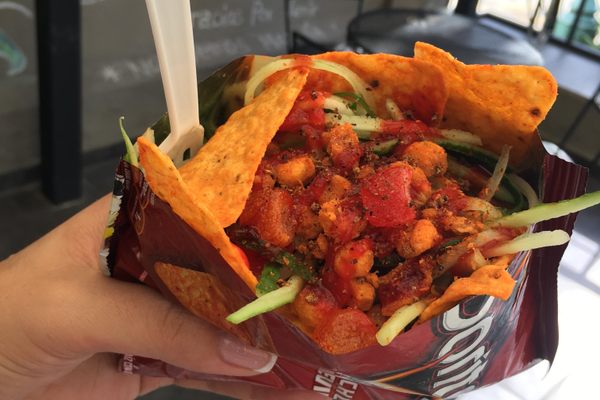Ingredients & Condiments
Blue-Green Algae
The Aztecs used it to make protein-rich tortillas; we use it to make unicorn lattes.
The cosmic-mermaid hue of blue-green algae may leave you wondering if calling someone “pond scum” is really an insult.
Blue-green algae extracts, often sold as “Blue Majik,” can add antioxidants, vitamins, and minerals to any dish rich and flavorful enough to camouflage their unpleasant taste. Despite what some reviewers describe as “bitter fishy seaweed notes,” chefs and baristas are adding Blue Majik to everything from chia pudding and yogurt bowls to ice cream and lattes. The result is a gorgeous, robin’s egg blue that will make any dish pop. Australians, in particular, are big fans.
The extracts get their magic blue color from a chemical called C-Phycocyanin. Scientists extract this natural compound from spirulina, a blue-green micro-algae that grows in lakes around the world. The resulting pigment is all-natural and safe for turning food and drugs impossibly blue.
Although it’s only recently surged in popularity across Instagram and new-wave health circles, cultures have been consuming blue-green algae for hundreds of years. In Central Mexico, Spanish chroniclers described Aztec fishermen living around Lake Texcoco collecting blue-green algae, which they called tecuitlatl, and adding it to roasted corn and tortillas. Central-African women living around Lake Chad still collect spirulina, which they form into sun-dried cakes called dihé.
Researchers have yet to put newer products like Blue Majik to the test, but scientists have looked into spirulina’s many potential applications. A study in the journal Nutrition and Cancer examined Indian people who had oral lesions from chewing paan (a combination of tobacco, betel leaf, and spices). After one year, 45 percent of those who took a daily spirulina supplement saw a “complete regression of lesions,” while only 7 percent of the placebo group saw comparable improvement.
While spirulina is nutritious, it isn’t any old algae. Some strains of blue-green algae can be toxic, so make sure you’re dealing with a safe version first.
Written By
 rachelrummel
rachelrummel
Sources
- www.scielo.br/pdf/bjce/v28n1/a06v28n1.pdf
- www.bonappetit.com/story/how-to-use-blue-majik
- www.algaeindustrymagazine.com/special-report-spirulina-part-2-first-human-consumption-and-cultivation/
- www.fondazioneslowfood.com/en/ark-of-taste-slow-food/dihe-spirulina-2/
- www.umm.edu/health/medical/altmed/supplement/spirulina
- www.ncbi.nlm.nih.gov/pmc/articles/PMC4042564/
- www.ncbi.nlm.nih.gov/pubmed/12769719
- books.google.com/books?id=FJrr9i6HRp0C&pg=PA126&lpg=PA126&dq=texcoco+Tecuitlatl&source=bl&ots=6lP-iEAw7h&sig=CWL2GKaP2X5oYbuyOUtU1FsJako&hl=en&sa=X&ved=0ahUKEwjDhtK74oTYAhWoUd8KHZijA8oQ6AEISzAM#v=onepage&q=texcoco%20Tecuitlatl&f=false
- books.google.com/books?id=_0beD5LVNugC&pg=PA810&lpg=PA810&dq=texcoco+Tecuitlatl&source=bl&ots=WGaSTCAXrU&sig=2QzuekEbqfwxs6_AvOzGQJKTWQs&hl=en&sa=X&ved=0ahUKEwjDhtK74oTYAhWoUd8KHZijA8oQ6AEITTAN#v=onepage&q=texcoco%20Tecuitlatl&f=false
- www.ncbi.nlm.nih.gov/pubmed/8584455


















